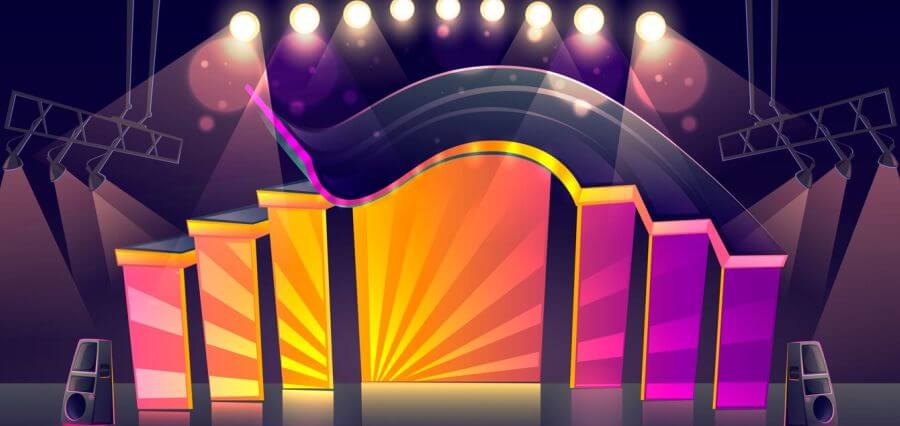A well-designed stage is crucial in creating impactful, unforgettable event experiences. It serves as the focal point in the venue where the main, important activities happen.
An impressive event stage design enhances the venue’s visual appeal, supports the event’s theme, and draws the attendees’ attention. It should accommodate the event’s technical requirements, including lighting, sound, and multimedia, ensuring seamless presentations.
The design must also ensure optimal visibility and engagement for the speaker or performer and audience members.
A great stage can elevate any gathering and leave a lasting impression on attendees and reinforce the event’s message.
How to Design the Ideal Stage for an Event?
Designing an impactful stage for any event requires a lot of thinking and planning. You can streamline the process and create the perfect design for the stage by following these tips:
1. Establish the purpose of the event.
To have a stage that fits in and elevates your event, know why the event is being held first. Are you hosting a conference, product launch or company party? Or is it a concert or an auction for fundraising purposes?
If you are organizing a concert or an event where there will be performers, such as dancers or a band, you need a stage large enough to accommodate the individual or group. It should also have room for the equipment and can be equipped with proper lighting and sound systems.
If you’re planning a conference or seminar, you can opt for a smaller venue and stage and equip it with only the essential audio and visual equipment.
2. Consider the size of the stage.
Stages come in different sizes, which is why you should know how big or small the one in your venue is before you start working on the design. A tiny stage can limit the speaker’s or performers’ movements, while an overly large stage can make the event feel sparse and impersonal.
If the stage is small and can’t be expanded, maximize the space by using multi-level platforms to create depth and dimension. You can also utilize modular pieces that can be rearranged to fit different segments of the event.
Consider using strategic lighting and projection mapping as well to enhance the perception of space.
Regardless of the stage’s size, ensure you use the space efficiently to allow the speakers and performers to move freely and arrange the props effectively to make them visually appealing and functional.
3. Incorporate the event theme.
The theme sets the tone, enhances the overall ambiance and injects a sense of cohesiveness into any event. Since the stage is the center point of the gathering, it should highlight or reinforce it.
Start by aligning the stage’s color scheme, props, and backdrop with the event theme. Incorporate thematic elements, such as textures, materials and brand features, in the decorations to create a cohesive visual narrative.
Integrate multimedia components, such as themed animations and graphics on screens, to reinforce the theme in an eye-catching manner. Also, ensure the lighting design matches the mood and tone of the event.
4. Choose an effective layout and an eye-catching color palette.
Once you have factored in the purpose, theme and size of the stage, you have to think about its layout and color scheme.
The layout should enable the audience to see the persons on stage and facilitate interaction between them. If the event has panel discussions, ensure it includes space for chairs and pathways for the speakers.
Additionally, make sure your color scheme reflects the event theme and creates the appropriate ambiance that can influence the attendees’ views and emotions. If you want your event to be lively and boost the guests’ engagement, incorporate yellow, red, orange and other vibrant hues in the stage design.
If your event requires a toned down, relaxing mood, include blue, green and neutral hues in your palette.
You can incorporate your color scheme in the posters, banners, fabrics and other materials you plan to put on and around the stage. You can also use lighting to highlight your chosen hues.
5. Incorporate the other essential elements.
Integrating the necessary audio and visual equipment is essential in perfecting your stage design. Choose a high-quality sound system to ensure the audience has clear audio for live performances and speeches.
Make sure the stage is equipped with advanced lighting solutions, including spotlights, LED panels, and mood lighting, to create the desired ambiance and highlight the event’s color theme and key areas of the stage. Ensure the equipment is strategically placed and tested to avoid technical issues during the event.
Also, include projection screens and video walls that display dynamic content, such as live feeds, presentations, and thematic visuals, in the design to enhance audience engagement. Ensure there are enough banners, posters, signage, and other essential branding elements on stage without making it crowded.
When you choose the right branding elements and incorporate them in your graphic design and printing correctly, you can have a visually cohesive stage that aligns with the event’s message.
Whether you’re hosting the event at a convention center, community center, or stadium, you can make the stage the focal point and ensure everything that takes place here goes smoothly by following these five tips.


